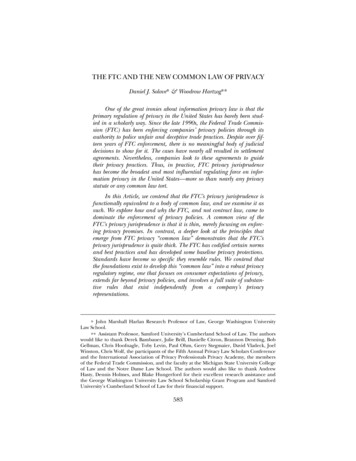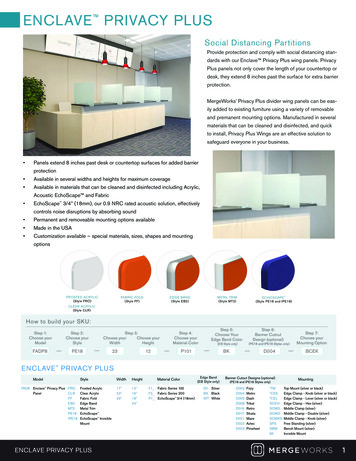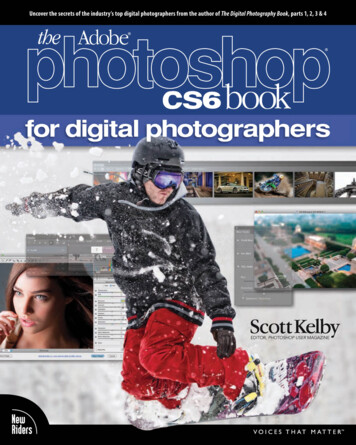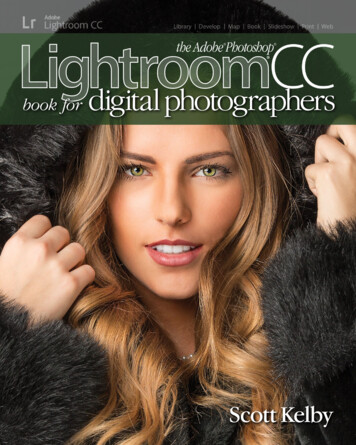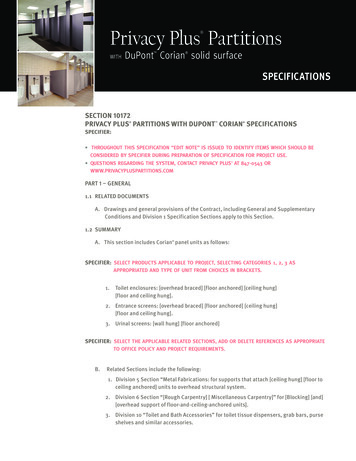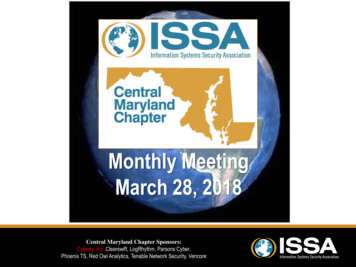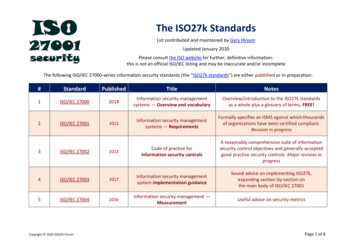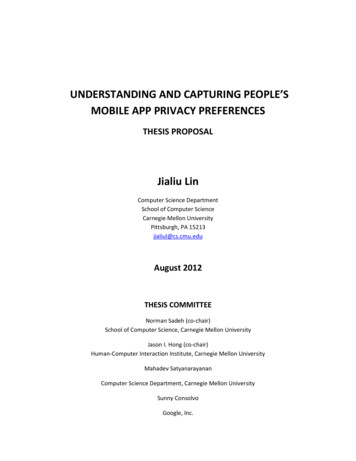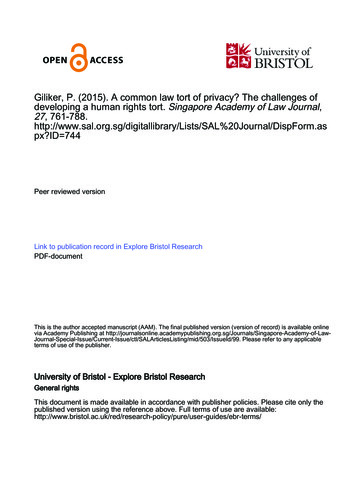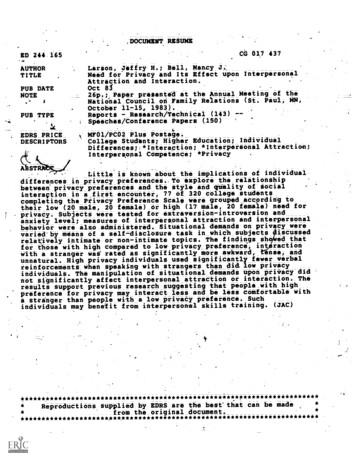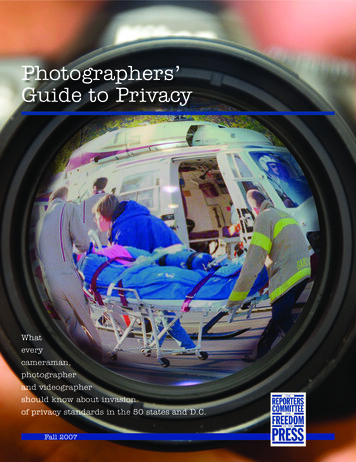
Transcription
Photographers’Guide to PrivacyWhateverycameraman,photographerand videographershould know about invasionof privacy standards in the 50 states and D.C.Fall 2007
A primer on invasion of privacyThe question of when the coverage andreporting of news becomes an invasionof privacy is a difficult one, especially forphotographers and videographers.Reporting news stories in a way thatserves and informs the public will often entailpublicizing facts or displaying images thatwill embarrass or anger someone.To make privacy matters even more difficult for journalists, courts constantly redefinewhat is private based upon interpretationsof the elusive legal standard of a “reasonableexpectation of privacy.”The California Supreme Court held in1999 that even an employee who knows aconversation in an open office space willbe overheard by coworkers can pursue aninvasion of privacy claim if that conversationis recorded by a reporter’s hidden camera.The court rejected the notion of privacy asan “all-or-nothing” concept and describedan “expectation of limited privacy.” (Sandersv. American Broadcasting Cos., Inc., 978 P.2d67 (Cal. 1999))The media can also be on the losing endof a multimillion-dollar verdict if a juryPhotographers’ Guide to PrivacyFall 2007The Reporters Committee is gratefulto legal intern Jaci Boydston for herwork in researching and updatingthis guide. She built on the work ofprevious fellows and interns. 2007 The Reporters Committeefor Freedom of the Press. All rightsreserved. This material may notbe reproduced without the writtenpermission of the ReportersCommittee.The Reporters Committee forFreedom of the Press1101 Wilson Blvd., Suite 1100Arlington, VA 22209(703) 807-2100web: www.rcfp.orgPage 2agrees that a news organization has omittedor played down facts that put a truthful statement in its proper context. In 2003, a Floridajury awarded 18 million to Joe Anderson,the owner of a road-paving company whosued over a Pensacola News Journal articlethat truthfully reported he had shot andkilled his wife. However, the fact that aninvestigation determined that the death wasa hunting accident was not mentioned untiltwo sentences later, which Anderson said created a false impression that he murdered hiswife. A midlevel appellate court overturnedthe verdict in 2006, but the case is now onappeal to the state supreme court.The combination of a lack of clear definitions of privacy standards and an acceptanceof gradations of privacy puts journalists in adangerous position.Under different circumstances, however,courts find the news media are justifiedin doing what their subjects may feel isinvasive.A federal district court in Oklahomadismissed a private facts claim when thefather of an Oklahoma Army National Guardsoldier killed in Iraq sued when photographsof his son’s open casket were published. Thecourt noted that the funeral was open tothe public and the press and that the fatherchose to have an open casket placed whereany attendee could walk up and see it. TheU.S. Court of Appeals in Denver (10th Cir.)upheld the dismissal, finding that since thesoldier’s family members “opened up thefuneral scene to the public eye,” they couldnot assert any invasion of privacy claim.(Showler v. Harper’s Magazine Foundation,222 Fed.Appx. 755 (10th Cir. 2007))The U.S. Court of Appeals in San Francisco (9th Cir.) dismissed a false claim from aSeattle public official who had been secretlyvideotaped by a reporter during her trip toa public administrators convention in LasVegas. The reporter, whose report revealedthat the plaintiff spent more time gamblingand shopping than she did attending theconference, was not found to have actedwith actual malice even though he testified that he wanted to “shock the public”by reporting a misuse of taxpayer money.(Harris v. City of Seattle, 152 Fed.Appx. 565(9th Cir. 2005))The invasion of another’s privacy is a“tort,” meaning a civil wrong against anotherthat results in injury.A privacy tort occurs when a person orentity breaches the duty to leave anotherperson alone. When journalists intrude ona person’s privacy and cause emotional ormonetary injury, they may be forced to paydamages.Each state has developed its own privacylaw, either through the common law, statutes,or both. The right to privacy is an evolvingbranch of the law, and in most jurisdictionsmany legal questions remain unsettled.The tort of “invasion of privacy” isdistinct from the constitutional right toprivacy, which protects against invasions bythe government, although journalists whoact jointly with government officials havebeen held to violate a person’s constitutionalprivacy right. Journalists should also knowthat their conduct may lead to other tortclaims, such as trespass or the intentionalinfliction of emotional distress.The First Amendment places some limitson the application of privacy law to the media.It does not, however, immunize the mediacompletely. To avoid lawsuits, journalistsmust know how the law in their jurisdictionbalances the competing interests of the pressand the public against the privacy interestsof the subjects of reports.Courts have recognized four majorbranches of privacy law: 1) unreasonableintrusion upon seclusion; 2) unreasonablerevelation of private facts; 3) unreasonablyplacing another person in a false light beforethe public; and 4) misappropriation of aperson’s name or likeness.The facts of a particular case may implicate more than one branch of privacylaw. Some states refuse to recognize one ormore of the four torts; other states replace orsupplement the common law with statutoryprivacy rights.This guide provides a general explanation of each privacy tort and related causesThe Reporters Committee for Freedom of the PressFall 2007
of action. The state case law section summarizes privacy cases involving photographyfrom federal and state courts throughoutthe country.Although photography poses someunique problems in privacy law, in general thelegal analysis for invasion of privacy throughimages parallels the analysis for invasionsthrough words. A complete examination ofthe privacy law in every jurisdiction is beyond the scope of this guide. However, theintroduction to each state summary noteswhich of the four privacy torts have beenrecognized in any context by the state.Intrusion:One who intentionally intrudes, physically or otherwise, upon the solitudeor seclusion of another or his privateaffairs or concerns, is subject to liabilityto the other for invasion of his privacy,if the intrusion would be highly offensive to a reasonable person.— Restatement (2nd) of Torts, § 652B.Intrusion claims generally arise from thenewsgathering process itself rather than frompublication or dissemination. For this reason,intrusion is the privacy tort photographersshould be most concerned with, since theiractions in the field can create liability, evenif none of their work is published.The tort of intrusion is related to trespass, and there are three general types ofintrusion claims: surreptitious surveillance,traditional trespass, and occasions whenconsent to enter a private area has been givenand then exceeded (such as when a reporteruses deceptive techniques to gain access tocertain areas).Private Facts:One who gives publicity to a matterconcerning the private life of anotheris subject to liability to the other forinvasion of privacy, if the matterpublicized is of a kind that (a) wouldbe highly offensive to a reasonableperson; and (b) is not of legitimateconcern to the public.— Restatement (2nd) of Torts, § 652D.Photographers should not be as immediately concerned with private facts claims asthey should be with intrusion claims, sincethere will usually be editorial oversight aboutwhich photographs are published. However,intrusive or potentially intrusive photography tactics could create liability, particularlyif photographs taken from private propertywithout permission are published. Absentspecial circumstances involving crime vicFall 2007tims and witnesses, photographs of almostanything visible in a public place do notgive rise to actions for publication of private facts.in their identities. Usually, using a relevantphotograph to illustrate a newsworthy articlewill not create liability, whereas using acelebrity’s image in an advertisement oftenwill. However, newsworthiness is not alwaysFalse Light:a defense to a misappropriation claim. TheU.S. Supreme Court has ruled that a newsOne who gives publicity to a matterbroadcast showing the entirety of the 15concerning another that places thesecond act of a “human cannonball” couldother before the public in a false lightviolate the man’s right to publicity, since theis subject to liability to the other forbroadcast could take the commercial valueinvasion of his privacy, (a) the false lightout of his performance by allowing spectatorsin which the other was placed would beto see it for free rather than requiring themhighly offensive to a reasonable perto buy tickets. Zacchini v. Scripps-Howardson, and (b) the actor had knowledgeBroadcasting Co., 433 U.S. 562 (1977).of or acted in reckless disregard as toBecause the use of a celebrity’s likenessthe falsity of the publicized matterin advertising may imply endorsement of aand the false light in which the otherproduct or service, a celebrity whose likenesswould be placed.is used without consent may also have a claim— Restatement (2nd) of Torts, § 652E.under the federal Lanham Act, 15 U.S.C. §1125(a), which prohibits false descriptionsPhotographs can lead to false light of products or their origins.claims when improperly captioned or whenimages are used to illustrate stories that Defenses To Privacy Suitsare not directly connected with the imageSeveral defenses are available to photogitself (for example, a photograph of a thin raphers and news organizations accused ofwoman taken for another purpose and later invasion of privacy.used to illustrate an article about bulimia).If the subject of the photograph has noHowever, a photograph that accurately de- reasonable expectation of privacy, then nopicts a situation that occurs in public view invasion of privacy is possible. Photographswill often not support a false light claim, taken in public places generally are not aceven if the person pictured is offended by tionable. Photos of crimes, arrests and accithe image (for example, in a Massachusetts dents usually are immune from “publicationcase, a man sued a newspaper for publishing of private facts” privacy claims because theya picture in which he can be seen standing are of “legitimate public concern,” which isin an unemployment line. Even though the an element of the tort.photograph created the false impression thatPublic figures, who voluntarily exposehe was there to pick up an unemployment themselves to scrutiny, waive much of theircheck, he could not recover because the right to privacy.photograph truthfully depicted events thatCorporations generally cannot claim aoccurred in a public place).right to privacy; unlike the defamation tort,The facts supporting a false light claim the right to privacy concerns the personalwill often give rise to a defamation claim as “right to be left alone” rather than reputation.well, but while defamation seeks to redress Heirs generally cannot file suit on behalf ofthe harm done to one’s reputation, false light deceased people, although some states makeseeks to redress emotional distress. Several exceptions for misappropriation claims.states do not recognize false light as a meansIf a subject does have a reasonable expectaof recovery, and some states have not decided tion of privacy, consent to have photographsone way or the other.taken and published is a defense to an invasionof privacy action.Misappropriation:In deciding whether to take and publisha questionable photograph, journalists mustOne who appropriates to his own useconsider many factors.or benefit the name or likeness ofThe following pages survey the privacyanother is subject to liability to thelaw of the 50 states and the District of Coother for invasion of privacy.lumbia, with emphasis on cases involving— Restatement (2nd) of Torts, § 652C.photography. In many states the courts havenot addressed or resolved questions aboutMisappropriation statutes usually have the scope of privacy law. Many cases turntwo purposes – protecting ordinary indi- on subtle distinctions of fact, and could beviduals from the mental distress that can decided either way. When in doubt, youaccompany the undesired commercial use should consult an attorney or call the Reof their name or image and protecting the porters Committee’s toll-free legal assistanceproperty interest that celebrities cultivate hotline: 1-800-336-4243. uPhotographers’ Guide to PrivacyPage 3
State-by-State Guide to Privacy LawThe following is a state-by-state listing of cases that news service had a right to record. Smithconcerning invasion of privacy by journalists. Where v. Suratt, 7 Alaska 416 (D. Alaska 1926).our research did not locate cases concerning a specifictype of invasion of privacy, that type of invasion of Arizonaprivacy is not addressed.Arizona recognizes the four privacy torts.Intrusion: An undercover television newsAlabamacrew gained access to a medical laboratory byIntrusion: In Alabama, a photographer posing as potential clients and secretly videocan be liable for wrongful intrusion if he taping meetings with a doctor. The doctor’sintentionally intrudes upon the solitude or intrusion claim failed because he had noseclusion of another if that intrusion would be reasonable expectation of privacy in an officehighly offensive to a reasonable person. When open to the public, and he could not reasonablya photographer took a picture of a group of expect to keep conversations with strangersmen sitting at a greyhound race, a judge found private. Further, the news crew did not act inthe photographer was not liable for intrusion, a highly offensive manner, because they put nobecause the men were in a public place where one in danger, did not invade anyone’s home,they could not have expected to be ‘secluded.’ and were pursuing a story on public health.Further, the photograph taken was not ‘highly Medical Laboratory Management Consultants v.offensive.’ Schifano v. Greene County Greyhound American Broadcasting Cos., Inc., 30 F.Supp. 2dPark, Inc., 624 So.2d 178 (Ala. 1993).1182 (D. Ariz. 1998).Private facts: Privacy rights are individualrights and cannot be asserted by the relatives Arkansasof a dead person. Fitch v. Voit, 624 So.2d 542The Arkansas Supreme Court has recog(Ala. 1993). Further, those who are public nized intrusion, false light, and misappropriafigures either by choice or by circumstance tion. There is little Supreme Court case lawhave waived their right to privacy at least so analyzing the private facts tort, but it appearsfar as the information published or broadcast as though that cause of action would be recis of a legitimate public interest. Abernathy v. ognized as well.Thornton, 83 So.2d 235 (Ala. 1955).Intrusion: A federal trial court upheld aFalse light: A photograph of men sitting at a subpoena seeking a television station’s outtakesgreyhound race depicted normal activities and in a privacy suit, implying that a woman whosedid not place them in a false light. The men surgery was filmed without her consent hadimplicitly consented to the photograph by grounds to sue for invasion of privacy. Williamsnot objecting to the photographer’s presence. v. American Broadcasting Co., 96 F.R.D. 658 (W.Schifano v. Greene County Greyhound Park, Inc., D. Ark. 1983).624 So.2d 178 (Ala. 1993). A photo taken of aFalse light: Publishing a photograph of anwoman whose dress blew up as she left a fun- elderly woman was actionable when it was usedhouse was an invasion of her privacy, because to illustrate a story that falsely stated she quitalthough the photo was taken in a public place, her job because an affair had left her pregnant.it depicted her at a moment when her status Peoples Bank & Trust Co. v. Globe Int’l Publishinginvoluntarily changed to one which would Inc., 978 F.2d 1065 (8th Cir. 1992).embarrass a person of reasonable sensitivities.Daily-Times Democrat v. Graham, 162 So.2d California474 (Ala. 1964).California recognizes the four privacy torts,Misappropriation: A photograph of men sit- and it has a misappropriation statute. Cal. Civ.ting at a greyhound race and used for advertising Code § 3344. California also has a law thatpurposes was not found to be misappropriation creates civil liability for news photographersbecause no unique quality or value was found who trespass and invade a person’s privacy within the photograph, and the men implicitly malicious intent, allowing a judge to tripleconsented to the photograph being taken. a jury’s damages award and award punitiveSchifano v. Greene County Greyhound Park, Inc., damages. Cal. Civ. Code § 1708.8. The law624 So.2d 178 (Ala. 1993).was amended in 2005 to create an additionalprivacy tort for assault committed with theAlaskaintention of capturing images or recordings ofThe Alaska Supreme Court has recognized the plaintiff. Anyone who commits an assaultintrusion, but only in a non-binding part of with the intention of photographing someonean opinion. A federal court recognized a false is liable for the full extent of damages laid outlight claim.in § 1708.8, even if no privacy is invaded.Misappropriation: A North Pole expeditionIntrusion: Undercover news reporterpaid for by a news service was a matter of public secretly videotaped the workplace conversainterest that photographers not employed by tions of employees at a telepsychic marketingPage 4company. Even though the employees lackeda complete expectation of privacy in thoseconversations, since they could be overheardby others, they may still recover because theywere covertly recorded. Sanders v. AmericanBroadcasting Companies, Inc., 978 P.2d 67 (Cal.1999).News show reporter wore a concealedcamera to an acting workshop to investigatepotential violations of California labor laws.The court allowed the intrusion claim to go forward to determine whether the workshop wasa private place and whether the newsgatheringmethod was highly offensive. A jury eventually found that one cannot reasonably expectan acting workshop to be private. Turnbell v.American Broadcasting Co., No. CV 03-3554SJO (FMOx) (C.D. Cal. Oct. 28, 2004).A man sued Out Magazine for publishing aphotograph of him dancing shirtless in a storyentitled “Dirty Dancing” about drug use andunsafe sex at wild parties. The court found nointrusion because the party the man attendedwas open to any member of the public whobought a ticket, at least 1,000 people were present, and he was dancing on an elevated platform.Prince v. Out Publishing, 30 Med. L. Rptr. 1289,2002 WL 7999 (Cal. Ct. App. 2002).A television network secretly videotaped anews producer’s conversation with a potentialsource as the two stood at the source’s doorstepand later aired a five-second excerpt of thevideotape, even though the source declined anon-camera interview. There was no physicalintrusion into the source’s privacy because shewas in full public view from the street whilespeaking with the producer, and the networkfilmed her from a public place across the street.In addition, the source spoke freely with theproducer and must have known the contentsof the conversation might be repeated, and thenetwork never revealed her name or address.Deteresa v. American Broadcasting Cos., Inc.,121 F.3d 460 (9th Cir. 1997). The CaliforniaSupreme Court adopted a different standardfor taping telephone conversations — a conversation is considered confidential if a party tothat conversation has an objectively reasonableexpectation that the conversation is not beingoverheard or recorded. Flanagan v. Flanagan,41 P.3d 575 (Cal. 2002).Two people injured in a car accident couldsue for intrusion based on the fact that a cameraman recorded emergency care given in a rescuehelicopter, regardless of the fact that the accidentvictims expected their conversations with rescueworkers in the helicopter to be overheard byothers and the fact that they could not claim aright of privacy at the accident scene prior tobeing moved to the helicopter. Shulman v. GroupW Productions, 955 P.2d 469 (Cal. 1998).The Reporters Committee for Freedom of the PressFall 2007
A television news broadcast about a judgewho was given the lowest rating possible ina poll of attorneys included footage of himleaving his home. The judge’s intrusion claimfailed because he was in public view when thefootage was filmed, and because the news crewdid not enter his property, contact him physically, endanger his safety, or disclose where helived. Aisenson v. American Broadcasting Co., 269Cal. Rptr. 379 (Cal. Ct. App. 1990).The wife of a heart attack victim had validclaims for trespass and intrusion against atelevision news crew that entered her homewithout her consent to videotape unsuccessfulattempts by paramedics to save her husband’slife. Miller v. National Broadcasting Co., 232 Cal.Rptr. 668 (Cal. Ct. App. 1986).The surreptitious recording and photographing of a “quack” doctor, who was laterconvicted of unauthorized practice of medicine, may constitute an intrusion. Subsequentpublication of the photos in Life magazine wasnot essential to the intrusion upon seclusionclaim, but was admissible to establish damages. Dietemann v. Time, Inc., 449 F.2d 245(9th Cir. 1971).A domestic violence victim who allowed atelevision news crew to come into her homecould not claim trespass or intrusion. It wasirrelevant to her trespass and intrusion claimsthat she asserted her consent to the media’spresence was obtained through fraud. A possible claim based solely on fraud or intentionalmisrepresentation did exist, though. Baugh v.CBS Inc., 828 F.Supp. 745 (N.D. Cal. 1993).Private Facts: The publication of a photoof revelers at a public “Exotic Erotic Ball”was protected because the activities wereobservable by thousands of strangers. Martinv. Penthouse, 12 Med. L. Rptr. 2058 (Cal. Ct.App. 1986).A domestic violence victim who was filmedin her home by a television news crew couldsue for disclosure of private facts because thefacts broadcast as a result of the news crew’spresence went beyond the information availablein a police report. Also, the broadcast may havebeen degrading, and the victim’s involvementin the domestic violence incident might nothave been newsworthy. Baugh v. CBS Inc., 828F.Supp. 745 (N.D. Cal. 1993).Broadcasting footage of rescue workershelping two car accident victims in an emergency helicopter did not create liability forpublication of private facts because the rescueefforts were newsworthy. Shulman v. Group WProductions, 955 P.2d 469 (Cal. 1998).False Light: A magazine and cable televisionnetwork ran photos of a children’s baseball teamto illustrate a story about adult coaches whomolest children on sports teams. The teammanager pleaded guilty to child molestationcharges, but the assistant coaches and playerswho were not molested raised a sufficient claimfor false light. M.G. v. Time Warner, Inc., 89Cal.App.4th 623 (2001).A photograph of an actress and a producerleaving a restaurant together, accompanied byFall 2007an article stating that they were dating – when,in fact, the producer’s wife was present at thetime the photograph was taken – might constitute false light invasion of privacy. Fellows v.National Enquirer, 721 P.2d 97 (Cal. 1986).A photograph of a married couple in an affectionate pose, taken without their knowledgeor permission, that was used to illustrate anarticle that said love at first sight was foundedupon sexual attraction alone and would befollowed by divorce was sufficient to establisha false light claim. Gill v. Curtis Publishing Co.,239 P.2d 630 (Cal. 1952).Videotape broadcast of a judge leaving hishome did not place him in a false light becauseit was a fair, accurate depiction of the personand scene and was not highly offensive. Aisensonv. American Broadcasting Co., 269 Cal. Rptr. 379(Cal. Ct. App. 1990).The juxtaposition of a picture of attendeesof an “Exotic Erotic Ball” with pictures ofperformers at the ball did not amount to falselight because the photos truthfully depictedboth the revelry and performances that occurred at the ball. Martin v. Penthouse, 12 Med.L. Rptr. 2058 (Cal. Ct. App. 1986).A sexually explicit magazine’s publication ofa cartoon and sequence of photographs portraying an anti-pornography activist could not beviewed by a reasonable reader as statements offact, and therefore, did not place the activist ina false light. Dworkin v. Hustler, 668 F.Supp.1408 (C.D. Cal. 1987), aff’d on other grounds,867 F.2d 1188 (9th Cir. 1989).A former baseball player who claimed hisimage appeared in a drawing used to advertisebeer could not pursue a false light claim againstthe advertisers because he was unable to showthat the advertisement caused any damage tohis business or property. Newcombe v. AdolphCoors Co., 157 F.3d 686 (9th Cir. 1998).Misappropriation: A court allowed a claimNine keys to avoidinginvasion of privacy suitsThe best hedge against invasion ofprivacy suits is knowledge of the law inthe jurisdiction in which the photographor videotape is shot and published orbroadcast. However, the line betweenjournalism that is protected by the FirstAmendment and state law, and journalismthat creates liability for invasion of privacy,is rarely clear.Before taking or publishing a questionable picture, a photojournalist might wantto consider several factors: Generally, what can be seen frompublic view can be photographed withoutlegal repercussions. Photographs taken inprivate places require consent. Even if people are photographed inpublic, beware of the context in whichthe picture is placed (such as an innocuous photo of recognizable teenagers ina story about the rise of teen violence).Use caution when utilizing file footage orphotographs to illustrate negative stories.Special effects can be used to render thesubjects unidentifiable. If consent is required, it must beobtained from someone who can validlygive it. For example, permission froma child or mentally handicapped personmay not be valid, and a tenant may not beauthorized to permit photographs of partsof the building not rented by the tenant. Consent to enter a home may notbe consent to photograph it. Consent exceeded can be the same as no consent at all. Although oral consent may protect thePhotographers’ Guide to Privacypress from liability for invasion of privacy,written consent is more likely to foreclosethe possibility of a lawsuit. However, asubject’s subsequent withdrawal of consentdoes not bar the publication of the photograph. It simply means that the journalistmay not assert consent as a defense if thesubject later files suit. In some states thecommercial use of a photograph requiresprior written consent. Permission from a police department to accompany officers who legallyenter private property may not immunizejournalists from invasion of privacy suits.In most states, authorities may denyphotographers access to crime scenes anddisaster areas. Public officials and public figures, andpeople who become involved in events ofpublic interest, have less right to privacythan do private persons. In some states, using hidden cameras,or audiotaping people without their consent, may invite criminal or civil penalties.See our guide, “Can We Tape?,” at www.rcfp.org/taping, for more information onstate eavesdropping laws. A photograph may intrude into aperson’s seclusion without being published. Intrusion can occur as soon as theimage is taken. Privacy laws vary widely from state tostate, and the law often is unclear within agiven state. If in doubt about a situation, acall to a media lawyer or to the ReportersCommittee may help you assess the risk.Page 5
v. Forum, 692 F.2d 634 (9th Cir. 1982).The “news account” exception to misappropriation under the California statute barredrecovery by a domestic violence victim who wasfilmed by a television news magazine. Baugh v.CBS Inc., 828 F.Supp. 745 (N.D. Cal. 1993).Advertisers who used a former professionalbaseball player’s likeness, without his consent,in a drawing that appeared in an advertisementfor beer misappropriated his image under common law and under the California statute, soto go forward by a professional model who long as the drawing could easily be identified assued a coffee company for using a photograph depicting the player. Newcombe v. Adolph Coorsof him on its label without compensating him Co., 157 F.3d 686 (9th Cir. 1998).or obtaining his permission. The case was sentback to the lower court to determine whether Coloradoany of the company’s profits could be attributedColorado recognizes intrusion, privateto the use of the model’s photograph. Christoff facts and misappropriation. In 2002, the statev. Nestle USA, Inc., 152 Cal. Rptr. 3d. 1439, Supreme Court ruled that it would no longer2007 WL 1874240 (June 29, 2007).recognize false light claims.Dustin Hoffman sued a magazine after aIntrusion: A private investigator who wascomputer-altered photograph of him, dressed hired to determine whether a business wasin drag as he was in the movie “Tootsie,” made violating zoning laws entered the businesshim appear to be wearing certain designer property with a telescopic lens. His actions didclothes and was published as part of a spring not intrude upon the business owners’ seclufashion story. Overturning a lower court’s deci- sion. The business owners had no legitimatesion in favor of the actor, the Ninth Circuit ruled expectation of privacy in areas of their propertyagainst Hoffman, finding that the magazine did visible from a public road, or in actions thatnot publish with actual malice and was not pure violated the law. The court also recognizedcommercial speech, meaning it was thus was that business properties often are subject aentitled to full First Amendment protection. diminis
Although photography poses some unique problems in privacy law, in general the legal analysis for invasion of privacy through images parallels the analysis for invasions through words. A complete examination of the privacy law in every jurisdiction is be-yond the scope of this guide
